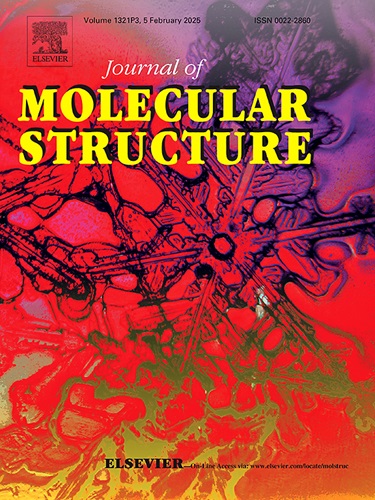利用赤道雌性 N4O2 供体配体构建具有零场慢磁弛豫的八配位 Dy(III) 复合物
IF 4
2区 化学
Q2 CHEMISTRY, PHYSICAL
引用次数: 0
摘要
利用赤道性副配体 N,N′-双吡啶-2-基-亚甲基-1,8-二氨基-3,6-二氧杂辛烷(L)和轴向配体五氟苯氧化物(F5PhO-)合成了一种空气稳定的单核 Dy(III) 单分子磁体 [Dy(L)(F5PhO)2](BPh4)(1)。配合物 1 显示出零场慢磁弛豫行为。当施加 200 Oe 的直接磁场时,观察到 1 有两个缓慢的弛豫过程;它们是由分子间偶极相互作用和磁矩反转引起的。额外的磁稀释实验产生了一种具有单一缓慢弛豫和 76(8) K 能量势垒的材料,表明分子间偶极相互作用引起的磁化量子隧道(QTM)被抑制了。本文章由计算机程序翻译,如有差异,请以英文原文为准。
Construction of an eight-coordinated Dy(III) complex with zero-field slow magnetic relaxation by using an equatorial sexadentate N4O2 donor ligand
An air-stable mononuclear Dy(III) single molecule magnet [Dy(L)(F5PhO)2](BPh4) (1) was synthesized using the equatorial sexadentate ligand N,N′-bis-pyridin-2-yl-methylene-1,8-diamino-3,6-dioxaoctane (L) and the axial ligand pentafluorophenoxide (F5PhO-). Complex 1 shows zero-field slow magnetic relaxation behavior. When a 200 Oe direct field was applied, two slow relaxation processes were observed for 1; they are caused by intermolecular dipole interactions and moment reversal. An additional magnetic dilution experiment resulted in a material with a single slow relaxation and an energy barrier of 76(8) K, indicating that quantum tunneling of the magnetization (QTM) induced by intermolecular dipolar interactions was suppressed.
求助全文
通过发布文献求助,成功后即可免费获取论文全文。
去求助
来源期刊

Journal of Molecular Structure
化学-物理化学
CiteScore
7.10
自引率
15.80%
发文量
2384
审稿时长
45 days
期刊介绍:
The Journal of Molecular Structure is dedicated to the publication of full-length articles and review papers, providing important new structural information on all types of chemical species including:
• Stable and unstable molecules in all types of environments (vapour, molecular beam, liquid, solution, liquid crystal, solid state, matrix-isolated, surface-absorbed etc.)
• Chemical intermediates
• Molecules in excited states
• Biological molecules
• Polymers.
The methods used may include any combination of spectroscopic and non-spectroscopic techniques, for example:
• Infrared spectroscopy (mid, far, near)
• Raman spectroscopy and non-linear Raman methods (CARS, etc.)
• Electronic absorption spectroscopy
• Optical rotatory dispersion and circular dichroism
• Fluorescence and phosphorescence techniques
• Electron spectroscopies (PES, XPS), EXAFS, etc.
• Microwave spectroscopy
• Electron diffraction
• NMR and ESR spectroscopies
• Mössbauer spectroscopy
• X-ray crystallography
• Charge Density Analyses
• Computational Studies (supplementing experimental methods)
We encourage publications combining theoretical and experimental approaches. The structural insights gained by the studies should be correlated with the properties, activity and/ or reactivity of the molecule under investigation and the relevance of this molecule and its implications should be discussed.
 求助内容:
求助内容: 应助结果提醒方式:
应助结果提醒方式:


